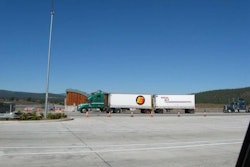
FTR Associates released preliminary data showing March Class 8 truck total net orders for all major North American OEMs at 10,505 units, 35.9 percent higher than February and 21.1 percent above March 2009. While the March preliminary numbers are the highest yet for 2010, the annualized order rate over the past three months is still below 100,000 units. The figure includes the United States, Canada, Mexico and exports.
“Each month in 2010, we have seen an improvement in orders for Class 8 vehicles, which is certainly encouraging,” says Eric Starks, FTR president. “However, we have not changed our overall outlook for 2010.” FTR believes the combination of excess capacity and the impact of the U.S. Environmental Protection Agency’s engine emissions mandate will hold Class 8 equipment demand this year “essentially flat” compared to 2009.
Current heavy truck capacity utilization is slightly above 75 percent and will have to get to at least 85 percent before it will have an impact on truck sales, says Noel Perry, FTR managing director and senior consultant. “It’s going to take a long time before we get up to significant new truck sales,” Perry says.
In the last nine months or so, fleets have been able to right-size their capacity to effectively match shipper demand for trucks. There is still a big surplus of used trucks parked in lots, but the number of trucks actively competing for freight is at equilibrium. “They right-sized like crazy,” Perry says. Current spot market shipping rates are tracking with rates in 2006 and 2008. “We are back to a normal seasonal pattern in 2010 [for spot market prices],” Perry says.
The manufacturing sector is more cyclical than the finished goods sector and will recover faster from this recession, while manufacturing likely will grow more rapidly over the next 10 years. “Manufacturers will look better than WalMart for a change,” Perry says.
Beginning this year and continuing into 2012, there will be a shortage of truck drivers from a modestly growing economy and tighter government regulation of drivers, creating capacity problems in the years ahead, Perry says. Carriers have cut overhead by removing trucks from service and laying off drivers – and have been slow to restore it.
“It’s almost certain that as the marketplace expands, even slowly as we’re forecasting, there will be a driver shortage,” he says. “If there’s a driver shortage, that means there’s a truck shortage.” Perry estimated the driver shortage could be close to 200,000 this year and grow to about 400,000 in 2011 and 2012. The shortages would be about evenly split between economic growth and federal regulatory requirements.
Perry predicts trucking growth of 4 to 6 percent over the next three years. He says that’s good compared with average growth figures over the last 30 years but conservative compared with previous upturns; in past upturns, growth in some quarters reached 10 percent or better. “Despite conservative growth estimates, we are explicitly forecasting capacity problems.”
Perry says the capacity shortage will result because the demand for drivers will exceed the system’s ability to provide drivers. “We’re not talking about availability of candidates, but the industry’s ability to process candidates,” including training, drug testing and processing, he says.












